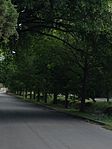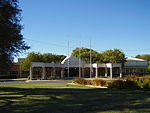Galindo, Austin, Texas
Galindo is a neighborhood in Austin, Texas. The area covers part of ZIP code 78704 in south Austin. Galindo is bounded to the south by Ben White Boulevard and the South Manchaca neighborhood, to the east by Dawson and South First Street, to the north by Oltorf Road and Bouldin Creek and to the west by the South Lamar neighborhood.Galindo maintains a primarily residential character, with most homes built in the 1950s and 1960s in either the ranch or bungalow style, though there is some new construction. The neighborhood anchor is the 11-acre South Austin Park and Recreation Center, located in the neighborhood's northwest section. Constructed in 1974, the park includes the South Austin Tennis Center, the only city-owned tennis center south of Colorado River.
Excerpt from the Wikipedia article Galindo, Austin, Texas (License: CC BY-SA 3.0, Authors).Galindo, Austin, Texas
Arroyo Seco, Austin
Geographical coordinates (GPS) Address Nearby Places Show on map
Geographical coordinates (GPS)
| Latitude | Longitude |
|---|---|
| N 30.339917 ° | E -97.730856 ° |
Address
Brentwood Elementary School
Arroyo Seco 6700
78757 Austin
Texas, United States
Open on Google Maps






